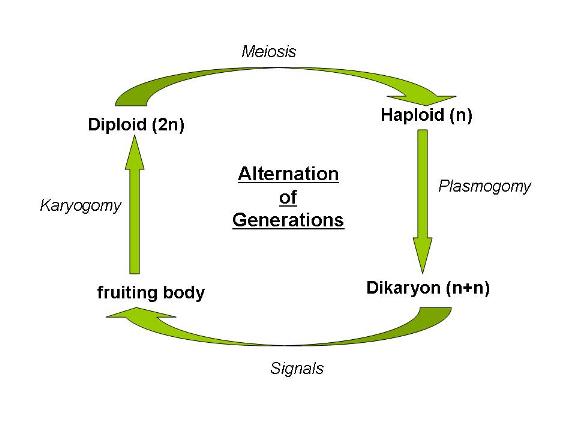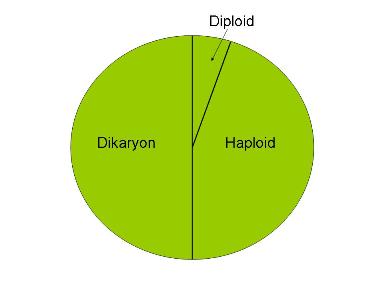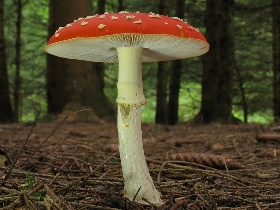
Reproduction
-
Being a member of the phyla Basidiomycota, A. muscaria reproduces sexually via sexual spores known as basidiospores.
-
The basidiospores are produced externally on cells called basidia, which line the gills of the club-shaped fruiting body, also known as the basidium.
-
One reason fungi have been such successful organisms is because they produce and distribute an immense amount of spores; A. muscaria is no different in this respect. This ensures that some spores will reach a substrate and germinate.
-
One vital interaction A. muscaria has is with herbivores, such as cattle and deer. By eating mushrooms, these herbivores unknowingly aid in the distribution of the basidia via their fecal matter. This interaction helps spread the basidia of A. muscaria to an extent that is much greater than the mushroom could have done on its own.
-
Below is an image diagramming the life-cycle of Amanita muscaria, which it shares with all other Basidiomycota.
 In this image, you can see an important characteristic of the
fungal life cycle, alternation of generations. Starting in
the upper right, two haploid mycellium fuse together (plasmogomy)
to yield a dikaryon mycellium. Upon receiving chemical
signals, the dikaryon develops into a fruiting body. The
dikaryon mycellium then undergoes karyogomy, where the two
nuclei it contains fuse into one. This forms a short-lived
diploid which almost immediately undergoes meiosis and returns
to the beginning of the cycle.
In this image, you can see an important characteristic of the
fungal life cycle, alternation of generations. Starting in
the upper right, two haploid mycellium fuse together (plasmogomy)
to yield a dikaryon mycellium. Upon receiving chemical
signals, the dikaryon develops into a fruiting body. The
dikaryon mycellium then undergoes karyogomy, where the two
nuclei it contains fuse into one. This forms a short-lived
diploid which almost immediately undergoes meiosis and returns
to the beginning of the cycle.

-
The pie chart above portrays the relative time A. muscaria spends in each of the three stages of the fungal life cycle. As one can see, A. muscaria spends a great deal of time in both the dikaryon and haploid phases while the diploid phase is relativlely short-lived.
To continue our journey, we will next take a look at the Adaptations A. muscaria has made to benefit itself in regards to nutrition and reproduction.
